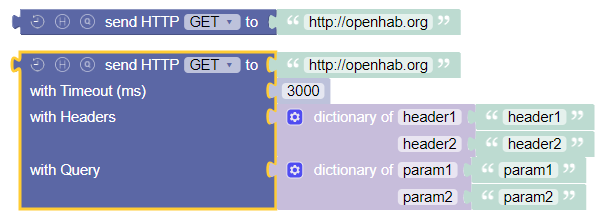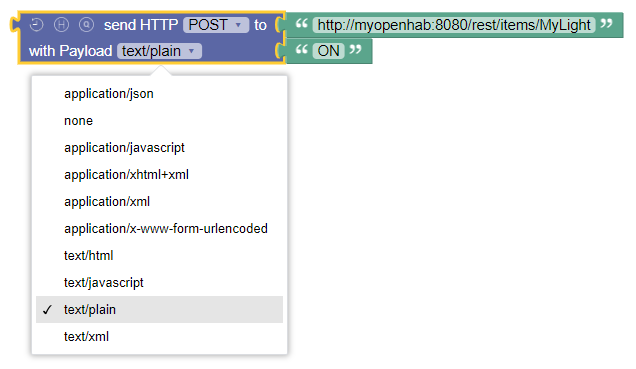# HTTP
# Introduction
This section explains the blocks that allow sending HTTP requests.
# HTTP Requests
There is one block that handles all type of requests. Depending on the required functionality it changes its design.

# Option Toggles
There are three toggle buttons that allow the block to be small for simple requests and add further options to be used:
- Clock: enables the timeout option
- H: enables the header option and allows to provide headers during the request via a Dictionary
- Q: enables the query option and allows to provide URI query parameters during the request via a Dictionary, the query parameters will be URI encoded
Query Parameters are used to provide additional information to the server, for example, to filter results or specify options for the request.
These are typically provided in the URI as key-value pairs, like ?key1=value1&key2=value2.
Instead of manually constructing the URI with query parameters, you can use the query option to provide a Dictionary of query parameters, which will be automatically URI encoded.
# HTTP Request GET
Function: Send an HTTP GET request to a server and receive the response
The simplest form is shown by default and accepts the destination URI as String, e.g., GET http://openhab.org. See below for an example of a GET request with query parameters (likehttp://example.com/api?param1=value1¶m2=value2` (opens new window)).
By activating the toggles the timeout, request headers and query parameters can be provided. Instead of creating a URI containing the query parameters, you can use the query parameter option and provide a Dictionary of query parameters. The provided parameters will automatically be URI encoded.
Here is an example also using a query parameter.

Another example shows how several query parameters can be provided using a Dictionary:
If you want to send a request with parameters like http://example.com/api?param1=value1¶m2=value2, the request can be constructed as follows:
- URI: http://example.com/api (opens new window) with two query parameters
param1andparam2- where
param1has a value that contains special characters, likeEncodedValueWithSpecialCharacters->! - and
param2has a value ofvalue2
- where
you can use the following block:

which results in the following request:
http://example.com/api?param1=EncodedValueWithSpecialCharacters->!¶m2=value2 (opens new window)
See the POST-Request below for an example showing the use additional fields.
# HTTP Request POST
Function: Send an HTTP POST request to a server and receive the response
The simplest form is shown by default and accepts the destination URI as String and in comparison to the GET-Request adds a section for the payload which takes two parameters:
- the MIME-type of the content to be sent
- the content to be sent to the destination
For MIME-type application/json you can provide an object as content, and it will be converted to a JSON string.
For application/x-www-form-urlencoded, you can provide a Dictionary and it will be URI encoded.

Here is a more complex example that additionally sets a header and a timeout:

# HTTP Request PUT
Function: Send an HTTP PUT request to a server and receive the response
The simplest form is shown by default and accepts the destination URI as String and is similar in functionality to the POST-Request:
- the MIME-type of the content to be sent
- the content to be sent to the destination

Notice the construction of an object with a Dictionary also containing a List for the JSON payload.
# HTTP Request DELETE
Function: Send an HTTP DELETE request to a server and receive the response
The simplest form is shown by default and accepts the destination URI as String.